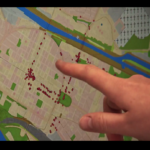Psychiatric research is increasingly interested in the influence of social and
environmental contexts on human health. According to recent findings, specific impacts of
urban upbringing on neural social stress processing relate to the heightened prevalence of mental disorders in cities.
Although this is a major societal problem, it remains unknown which environmental components (e.g., psychosocial stressors, air pollutants, rare nature exposure…) are responsible.
Method:
We introduce Ambulatory Assessment (AA) as a methodological approach to investigate contextual influences. In practice, GPS-triggered electronic diaries are suitable to capture data in everyday life, gathering information on both context and mental states to assess dynamic processes in real-life and real-time. Geoinformatics is
able to provide detailed information on spatial variations in environmental risk factors.
Result:
An ongoing longitudinal study at the Central Institute for Mental Health in Mannheim
combines AA, functional magnetic resonance imaging and epigenetic approaches to investigate the most relevant environmental factors influencing mental health. The findings might be incorporated in urban planning to reduce the risk of mental disorders.
Further details and a general overview is given in the recently accepted forthcoming journal paper:
Reichert, M., Törnros, T., Hoell, A., Dorn, H., Tost, H., Salize, H.-J., Meyer-Lindenberg, A., Zipf, A., & Ebner-Priemer, U. W. (in press). Using Ambulatory Assessment for experience sampling and the mapping of environmental risk factors in everyday life. Die Psychiatrie. 2016 (2).
A brief first analysis on the realized trigger only is very shortly presented in:
Dorn, H., Törnros, T., Reichert, M., Salize, H.J., Tost, H., Ebner-Priemer, U., Meyer-Lindenberg, A., Zipf, A. (2015): Incorporating Land Use in a Spatiotemporal Trigger for Ecological Momentary Assessments. In: Car, A., Jekel, T., Strobl, J., Griesebner, G. (Eds.), GI_Forum 2015 – Geospatial Minds for Society (pp. 113-116). Journal for Geographic Information Science, 1.
Related work investigates the use of OpenStreetMap as a potential data source:
Dorn, H., Törnros, T. & Zipf, A. (2015): Quality Evaluation of VGI using Authoritative Data – A Comparison with Land Use Data in Southern Germany. ISPRS International Journal of Geo-Information. Vol 4(3), pp. 1657-1671, doi: 10.3390/ijgi4031657
Törnros, T., Dorn, H., Hahmann, S., and Zipf, A. (2015): Uncertainties of completeness measures in OpenStreetMap – A Case Study for buildings in a medium-sized German city, ISPRS Ann. Photogramm. Remote Sens. Spatial Inf. Sci., II-3/W5, 353-357, doi:10.5194/isprsannals-II-3-W5-353-2015.



